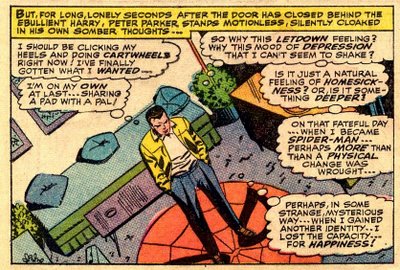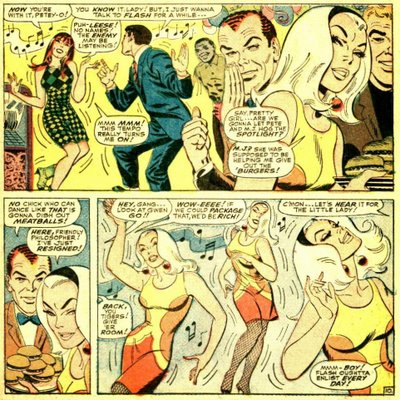ASM #46 starts rather abruptly. Spidey, his arm still in a sling from his battle with the Lizard in #44, encounters the Shocker, a guy with special vibrating gloves which give him extraordinary power. He kayos Peter and gets away.
The next big event in Peter's life comes later. Harry Osborn's dad has rented an apartment for him close to Empire State U. He invites Peter to take the second bedroom. Of course, our hero is thrilled at the prospect, but has to figure out whether it would be an inconvenience to Aunt May. Fortunately, she has already decided to move in with Anna Watson, so for once things seem to be breaking Peter's way. At this point he appears to be casually dating Mary Jane, but Gwen is starting to interest him more.
Spidey handles the Shocker in their second battle by not allowing the crook to use his thumbs on the vibrating gloves. Some modest pop culture and political references; Spidey mentions Hubert Humphrey and The Man from UNCLE. Still, we get some inevitable teenage angst here:

Kraven returns in #47, as well as (briefly, in flashback) the Green Goblin. We learn that Gobby had hired Kraven to attack Spiderman in ASM #34, something that was not disclosed at that time. In addition, Norman Osborn himself (aka the Green Goblin) had acted as a go-between, exposing himself as a crook to Kraven.
Kraven has developed a new ray that will eliminate Spidey's super-speed, and is confident once that is gone he will be able to subdue Webhead. We get a long dose of the Archie stuff:

But eventually the battle starts. Kraven decides to kidnap Harry, who's with Peter at a going-away party for Flash Thompson, who's been drafted into the army as discussed in earlier issues. Peter sneaks away and reappears as Spiderman. He taunts Kraven into dropping Harry and they fight. This time Kraven defeats him with his ray, but stops short of killing him when Norman Osborn shows up. However Kraven is baffled when his jungle senses tell him that Osborn doesn't remember him at all. Of course, he had no way of knowing that Osborn has amnesia about his Green Goblin years. Kraven decides that his victory over Spiderman is enough and dashes off.






























































